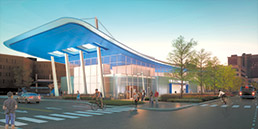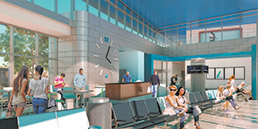Subscriber Benefit
As a subscriber you can listen to articles at work, in the car, or while you work out. Subscribe Now
 Buses get no respect. Romance clings to the rails and to the grand stations that serve them. When you take a train, you may well find yourself in a replica of a Greek temple or the Baths of Caracalla.
Buses get no respect. Romance clings to the rails and to the grand stations that serve them. When you take a train, you may well find yourself in a replica of a Greek temple or the Baths of Caracalla.
Wait for the bus, and if there’s any shelter at all, more likely than not it’s an unattractive construction more attuned to the buyers of the advertising it’s plastered with than keeping commuters out of the wind and rain.
Indianapolis is making a brave attempt to change that equation with its proposed IndyGo transit hub, and the agency has its work cut out for it. As the great expanse of surface parking lots attest, Indianapolis residents are not especially fond of the very idea of public transit. Even with the number of riders last year at a 23-year high, the level of bus ridership in Indianapolis is less than a fifth of Chicago’s.
Not only is the transit hub expected to make the idea of taking the bus more attractive with a new central transfer point, it’s also expected to help redeem with striking architecture one of the less-inviting areas of Indianapolis’ center city.
Only blocks from the shining skyscrapers, proud old buildings and beautiful memorials of the city center, the site of the transit hub is one of those places, as in many American cities, where downtown simply drops off as if from the edge of the earth. It becomes an encirclement of infrastructure—great seas of surface parking lots, a massive jail, the amazing hulk of the 2,200-car Virginia Avenue garage, a Chinese wall of a railroad viaduct. It’s all about getting in your car, parking at Virginia Avenue, and crossing the pedestrian skyway to Bankers Life Fieldhouse without ever having to engage the rest of the city.
It’s so mid-20th century, the wholesale razing of block upon block for parking lots and large-scale garages.
 The design of IndyGo’s $20 million transit station promises visual enlightenment for a part of the downtown long littered with parking lots, with the upswept cantilevers likely to become landmarks in their own right. A critical question remaining to be answered, however, is whether the city will keep the station fresh and inviting. (Image courtesy of IndyGo)
The design of IndyGo’s $20 million transit station promises visual enlightenment for a part of the downtown long littered with parking lots, with the upswept cantilevers likely to become landmarks in their own right. A critical question remaining to be answered, however, is whether the city will keep the station fresh and inviting. (Image courtesy of IndyGo)American cities in the 21st century are more about getting people out of their cars and revitalizing the streets by increasing pedestrian traffic. About changing the texture of the city to accommodate the rising number of people who want to live downtown.
Indianapolis is no exception. Even as a new 28-story apartment tower and a $30 million office building for Cummins have recently been announced to rise just a block north, the new transit hub is poised to further extend a truly urban fabric over what is now a “nowhere” of parked cars.
The architecture of the transit center, by San Francisco-based URS Corp. and local firm Axis Architecture + Interiors, is already hotly debated in Indianapolis.
And in the eyes of this outsider? Let’s face it; it’s not earth-shaking, but then it’s not really meant to be.
Below the roofline, it looks not unlike a rest stop along a highway. Some glass, some solids, color frames marking the entrances. The real signature elements of the design come above, in the raised roof with distinctive blue underside and suspended upswept cantilever at the end, echoed in a smaller blue canopy along Delaware.
If nothing else, these structures could help define the hub in the public’s mind: “Meet me at the flying blue tongues.”
And don’t underestimate the value of a handsome garden. It’s always dicey to judge the finished product from the renderings created to sell it, but the garden as pictured in rendering is especially varied and colorful in its plantings. Often, the grounds can make or break a building, and an exceptional plaza can sometimes even save a mediocre one.
The weakest point of the design isn’t even a problem now, as much as it may be in the future.
The upside of a transit hub is that it can have a distinctive structure as its visual anchor. The downside is that there are buses, and you have to put them somewhere. In the case of the new transit hub, those buses are hidden behind the terminal building and garden, the driveway camouflaged by a high metal screen.
This is essentially the loading dock of the complex, and it’s designed in a more frankly utilitarian way than the gateway side of the hub on Washington. Which is fine for now, as the bus loading area faces the stark brick fortress of the Marion County Jail.
 The interior bears similarities to an interstate rest stope. (Image courtesy of IndyGo)
The interior bears similarities to an interstate rest stope. (Image courtesy of IndyGo)If, however, the jail is relocated, as seems to be a distinct possibility, the “back alley” portion of the transit hub could become a visual drag on development of the jail site to the south.
No matter how attractive the facility turns out to be on the day of its dedication, a key, perhaps decisive, factor in the building’s success or failure will be ongoing maintenance.
Especially when funding grows tight, bus stations have a way of going derelict. The steel isn’t repainted and becomes stippled with corrosion. Repairs are cheap and cursory. Clocks stop working. Locks go on the rest rooms. The baby blue of the canopies fades to a dusty shadow. The facility gains a reputation—deserved or not—of being a refuge for transients.
Once that becomes a part of the local “street smarts,” the process feeds upon itself, as commuters increasingly think of the building as unpleasant or unsafe. Not only is the building shunned, the taint extends to the very idea of public transit. Once a plus, the structure becomes a blight on the surrounding area, depressing new development.
To a Chicagoan, the projected $19.5 million cost of the transit hub seems a great bargain. Here, the rehab of a single “L” station has been announced at $23 million. Another is going for $200 million, and the reconstruction of the 95th Street terminus of the Chicago Transit Authority’s Red Line—with a bus terminal not unlike the one in Indianapolis—is budgeted at a cool quarter billion.
Of course, if Indianapolis really wanted to put itself on the world architectural map, it could scare up a billion or two of its own and get Santiago Calatrava to do the design, but to paraphrase Freud, sometimes a bus station is just a bus station. Done right, that should be enough.•
__________
Becker blogs about architecture at ArchitectureChicago Plus. Send comments on this review to ibjedit@ibj.com.
Please enable JavaScript to view this content.
